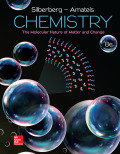
Concept explainers
(a)
Interpretation:
Species among
Concept introduction:
(a)
Answer to Problem 19.142P
Among all the three species,
Explanation of Solution
The equation considered as,
Now, for the 1st equation,
Now, for the 2nd equation,
From the above data it is shown that,
If
Again,
Hence among all the three species
(b)
Interpretation:
At
Concept introduction:
Henderson-Hasselbalch Equation:
This equation is used to determine the
(b)
Answer to Problem 19.142P
The value of concentration ratios of
Explanation of Solution
The equation considered as,
For the 1st equation,
Thus the
Thus the
The value of concentration ratios of
For the 2nd equation,
Thus the
Thus the
The value of concentration ratios of
Thus the value of concentration ratios of
(c)
Interpretation:
Reason for lower
Concept introduction:
Photosynthesis:
The process of photosynthesis occurs in plants for their survival. In this process carbon dioxide is absorbed from nature and oxygen is released to nature by plants. Sunlight is the main important component for photosynthesis to occur. Here glucose is formed.
Respiration:
Respiration is a biochemical process in which in the cells of organisms energy is evolved due to reaction between oxygen and glucose and by this process carbon dioxide is released along with water and ATP
(c)
Explanation of Solution
The acidity of the sea water is due to presence of dissolved carbon dioxide in the water.
On the upper sea level there are plants and also on upper level of sea sunlight can enter. As a result of that on the upper level of sea photosynthesis occurs and according to the process of photosynthesis carbon dioxide is taken up by plants. This results a decrease in the dissolved carbon dioxide concentration in the upper sea level.
But still due to the respiration by the sea animals and the plants at upper level there will be some amount of dissolved carbon dioxide in the upper level. So sea water at upper level is acidic but less in amount.
However, in deep sea level,
Hence, deep sea water has a higher acidity the value of
Want to see more full solutions like this?
Chapter 19 Solutions
EBK CHEMISTRY: THE MOLECULAR NATURE OF
 ChemistryChemistryISBN:9781305957404Author:Steven S. Zumdahl, Susan A. Zumdahl, Donald J. DeCostePublisher:Cengage Learning
ChemistryChemistryISBN:9781305957404Author:Steven S. Zumdahl, Susan A. Zumdahl, Donald J. DeCostePublisher:Cengage Learning ChemistryChemistryISBN:9781259911156Author:Raymond Chang Dr., Jason Overby ProfessorPublisher:McGraw-Hill Education
ChemistryChemistryISBN:9781259911156Author:Raymond Chang Dr., Jason Overby ProfessorPublisher:McGraw-Hill Education Principles of Instrumental AnalysisChemistryISBN:9781305577213Author:Douglas A. Skoog, F. James Holler, Stanley R. CrouchPublisher:Cengage Learning
Principles of Instrumental AnalysisChemistryISBN:9781305577213Author:Douglas A. Skoog, F. James Holler, Stanley R. CrouchPublisher:Cengage Learning Organic ChemistryChemistryISBN:9780078021558Author:Janice Gorzynski Smith Dr.Publisher:McGraw-Hill Education
Organic ChemistryChemistryISBN:9780078021558Author:Janice Gorzynski Smith Dr.Publisher:McGraw-Hill Education Chemistry: Principles and ReactionsChemistryISBN:9781305079373Author:William L. Masterton, Cecile N. HurleyPublisher:Cengage Learning
Chemistry: Principles and ReactionsChemistryISBN:9781305079373Author:William L. Masterton, Cecile N. HurleyPublisher:Cengage Learning Elementary Principles of Chemical Processes, Bind...ChemistryISBN:9781118431221Author:Richard M. Felder, Ronald W. Rousseau, Lisa G. BullardPublisher:WILEY
Elementary Principles of Chemical Processes, Bind...ChemistryISBN:9781118431221Author:Richard M. Felder, Ronald W. Rousseau, Lisa G. BullardPublisher:WILEY





